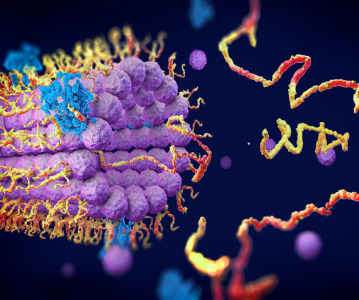New technology can detect tiny ovarian tumours

“Synthetic biomarkers” could be used to diagnose ovarian cancer months earlier than now possible.
Most ovarian cancer is diagnosed at such late stages that patients’ survival rates are poor. However, if the cancer is detected earlier, 5-year survival rates can be greater than 90%.
Now, MIT engineers have developed a far more sensitive way to reveal ovarian tumours: In tests in mice, they were able to detect tumours composed of nodules smaller than 2 mm in diameter. In humans, that could translate to tumour detection about 5 months earlier than is possible with existing blood tests, the researchers say.
The new test makes use of a “synthetic biomarker” — a nanoparticle that interacts with tumour proteins to release fragments that can be detected in a patient’s urine sample. This kind of test can generate a much clearer signal than natural biomarkers found in very small quantities in the patient’s bloodstream.
“What we did in this paper is engineer our sensor to be about 15 times better than a previous version, and then compared it against a blood biomarker in a mouse model of ovarian cancer to show that we could beat it,” says Sangeeta Bhatia, the John and Dorothy Wilson Professor of Health Sciences and Technology and Electrical Engineering and Computer Science, a member of MIT’s Koch Institute for Integrative Cancer Research and Institute for Medical Engineering and Science, and the senior author of the study.
This approach could also be adapted to work with other cancers. In this paper, which appears in the April 10 issue of Nature Biomedical Engineering, the researchers showed they can detect colorectal tumours that metastasized to the liver.
The paper’s lead authors are postdoc Ester Kwon and graduate student Jaideep Dudani.
Synthetic biomarkers
Bhatia first reported the strategy of diagnosing cancer with synthetic biomarkers in 2012. This method measures the activity of protein-cutting enzymes called endoproteases, which are made by tumours to help recruit blood vessels and invade surrounding tissues so the cancer can grow and spread.
To detect this sort of enzyme, the researchers designed nanoparticles coated with small protein fragments called peptides that can be cleaved by particular proteases called MMPs. After being injected into a mouse, these particles passively collect at the tumour site. MMPs cleave the peptides to liberate tiny reporter fragments, which are then filtered out by the kidney and concentrated in the urine, where they can be detected using various methods, including a simple paper-based test.
In a paper published in 2015, the researchers created a mathematical model of this system, to understand several factors such as how the particles circulate in the body, how efficiently they encounter the protease, and at what rate the protease cleaves the peptides. This model showed that in order to detect tumours 5 mm in diameter or smaller in humans, the researchers would need to improve the system’s sensitivity by at least one order of magnitude.
In the current study, the researchers used two new strategies to boost the sensitivity of their detector. The first was to optimize the length of the polymer that tethers the peptides to the nanoparticle. For reasons not yet fully understood, when the tether is a particular length, specific proteases cleave peptides at a higher rate. This optimization also decreases the amount of background cleavage by a nontarget enzyme.
Second, the researchers added a targeting molecule known as a tumor-penetrating peptide to the nanoparticles, which causes them to accumulate at the tumor in greater numbers and results in boosting the number of cleaved peptides that end up secreted in the urine.
By combining these two refinements, the researchers were able to enhance the sensitivity of the sensor 15-fold, which they showed was enough to detect ovarian cancer composed of small tumours (2 mm in diameter) in mice. They also tested this approach in the liver, where they were able to detect tumours that originated in the colon. In humans, colon cancer often spreads to the liver and forms small tumors that are difficult to detect, similar to ovarian tumours.
Earlier diagnosis
Currently, doctors can look for blood biomarkers produced by ovarian tumours, but these markers don’t accumulate in great enough concentrations to be detected until the tumours are about 1 cm in diameter, about eight to 10 years after they form. Another diagnostic tool, ultrasound imaging, is also limited to ovarian tumours that are 1 centimeter in diameter or larger.
Being able to detect a tumour 5 months earlier, which the MIT researchers believe their new technique could do, could make a significant difference for some patients. In this paper, the researchers also showed that they could detect disease proteases in microarrays of many tumour cells taken from different cancer patients. This strategy could eventually help the researchers to determine which peptides to use for different types of cancer, and even for individual patients.
“Every patient’s tumour is different, and not every tumour will be amenable to targeting with the same molecule,” Bhatia says. “This is a tool that will help us to exploit the modularity of the technology and personalize formulations.”
The researchers are now further investigating the possibility of using this approach on other cancers, including prostate cancer, where it could be used to distinguish more aggressive tumours from those that grow much more slowly, Bhatia says.
The research was funded by a Koch Institute Support Grant from the National Cancer Institute, a Core Center Grant from the National Institute of Environmental Health Sciences, a Ruth L. Kirschstein National Research Service Award, a National Science Foundation Graduate Research Fellowship, the Koch Institute Marble Center for Cancer Nanomedicine, and the Howard Hughes Medical Institute.
Related News
-
News A Day in the Life of a Start-Up Founder and CEO
At CPHI we work to support Start-Up companies in the pharmaceutical industry and recognise the expertise and innovative angles they bring to the field. Through our Start-Up Programme we have gotten to know some of these leaders, and in this Day in the ... -
News Biopharmaceutical manufacturing boost part of new UK government budget
In their national budget announced by the UK Labour Party, biopharmaceutical production and manufacturing are set to receive a significant boost in capital grants through the Life Sciences Innovative Manufacturing Fund (LSIMF). -
News CPHI Podcast Series: The power of proteins in antibody drug development
In the latest episode of the CPHI Podcast Series, Lucy Chard is joined by Thomas Cornell from Abzena to discuss protein engineering for drug design and development. -
News Amgen sues Samsung biologics unit over biosimilar for bone disease
Samsung Bioepis, the biologics unit of Samsung, has been issued a lawsuit brought forth by Amgen over proposed biosimilars of Amgen’s bone drugs Prolia and Xgeva. -
News CPHI Podcast Series: Why we need to consider women in clinical trials
The latest episode of the CPHI Podcast Series with Lucy Chard covers women's health, specifically women's representation in clinical trials, the associated bias, and the impacts on health for this population. -
News US FDA does not approve MDMA therapy for PTSD, requests more data
The MDMA-based therapeutic developed by Lykos Therapeutics, a California-based Public Benefit Corporation (PBC), has been reviewed and unapproved by the US FDA. The regulator has requested additional phase III trial data for further safety and efficacy... -
News Novartis and Viatris latest facing lawsuit over HeLa cell misuse
Global pharmaceutical companies Novartis and Viatris are the latest hit with a lawsuit claim pertaining to alleged misuse of the ‘HeLa’ cell line from the estate of woman whose cancerous tissue cells were taken without consent. -
News Sanofi invests billions into Frankfurt insulin production site
French pharmaceutical company Sanofi have announced an investment of EUR1.3 billion at their existing BioCampus site in Frankfurt am Main for the expansion of insulin production.
Position your company at the heart of the global Pharma industry with a CPHI Online membership
-
Your products and solutions visible to thousands of visitors within the largest Pharma marketplace
-
Generate high-quality, engaged leads for your business, all year round
-
Promote your business as the industry’s thought-leader by hosting your reports, brochures and videos within your profile
-
Your company’s profile boosted at all participating CPHI events
-
An easy-to-use platform with a detailed dashboard showing your leads and performance



.png)

.png)
.png)
.png)